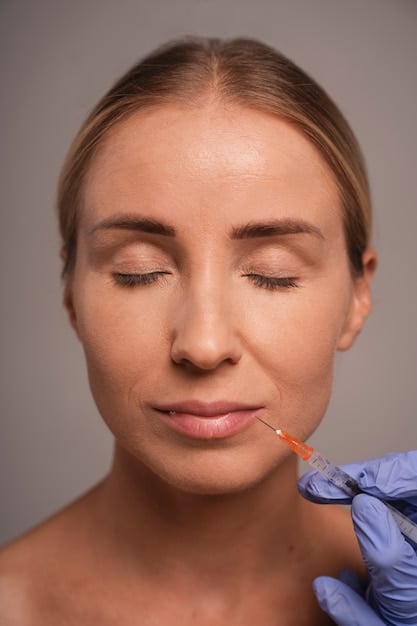Facial Thread Lifts: Are They Worth It for a Subtle Lift?

Facial thread lifts offer a minimally invasive approach to achieving a subtle, approximately 10% lift. Whether they’re worth the investment depends on individual expectations, budget, and tolerance for temporary results compared to more invasive surgical options.
Are you considering a facial thread lift for a subtle rejuvenation? Facial thread lifts: Are They Worth the Investment for a 10% Noticeable Lift? This guide breaks down the pros, cons, costs, and expectations to help you decide.
Understanding Facial Thread Lifts
Facial thread lifts have emerged as a popular alternative to traditional facelift surgery. But what exactly are they, and how do they work?
This section delves into the details of facial thread lifts, exploring the procedure, the types of threads used, and the expected outcomes.
What is a Thread Lift?
A thread lift is a cosmetic procedure that uses dissolvable sutures to lift and tighten sagging skin. Unlike a traditional facelift, it’s less invasive, requiring only local anesthesia and minimal downtime.
Types of Threads Used
Various types of threads are used in thread lifts, each with its own characteristics and benefits. Common materials include PDO (polydioxanone), PLLA (poly-L-lactic acid), and PCA (polycaprolactone).
- PDO Threads: These are the most commonly used threads and provide a shorter-lasting lift.
- PLLA Threads: These threads stimulate collagen production, offering a longer-lasting effect.
- PCA Threads: Similar to PLLA, PCA threads also boost collagen and provide extended results.

In conclusion, facial thread lifts offer a minimally invasive solution for those seeking a subtle lift. Understanding the procedure and the types of threads used is crucial for setting realistic expectations.
The Procedure: What to Expect
If you’re considering a thread lift, it’s important to know what to expect during the procedure. From preparation to recovery, this section provides a comprehensive overview.
This will help you prepare mentally and physically for the process, ensuring a smooth and comfortable experience.
Before the Procedure
Before the thread lift, a consultation with a qualified practitioner is essential. During this consultation, the practitioner will assess your facial structure, discuss your goals, and explain the procedure in detail.
During the Procedure
The thread lift procedure typically takes about 30 to 60 minutes. After cleaning and numbing the treatment area with local anesthesia, the practitioner inserts the threads using a needle or cannula.
Aftercare and Recovery
Following the thread lift, some mild swelling, bruising, and discomfort are normal. The recovery period is relatively short, with most people returning to their normal activities within a few days.
Overall, the thread lift procedure is relatively straightforward, with minimal downtime. Proper preparation and aftercare are key for achieving the best possible results.
Expected Results: The 10% Lift
One of the most important considerations when contemplating a thread lift is the expected results. How much of a lift can you realistically achieve?
This section focuses on the subtle yet noticeable changes that a thread lift can provide, often described as a 10% lift.
The results of a thread lift are often described as a subtle lift, typically around 10%. This may not seem like much, but it can make a noticeable difference in overall facial appearance.
Subtle but Noticeable Changes
The threads lift sagging skin, reducing the appearance of wrinkles and fine lines. The result is a more youthful and refreshed look.
Collagen Stimulation
In addition to the immediate lifting effect, thread lifts also stimulate collagen production. Over time, this can improve skin elasticity and firmness.

Longevity of Results
The results of a thread lift are not permanent. Typically, the effects last from 1 to 3 years, depending on the type of threads used and individual factors.
In conclusion, while a thread lift provides a subtle lift, it can still make a noticeable difference in facial appearance. The collagen stimulation and relatively short recovery make it an attractive option for many.
The Cost Factor: Is It Worth the Investment?
Cost is a significant factor for anyone considering a cosmetic procedure. How much does a thread lift cost, and is it a worthwhile investment?
This part of the article examines the financial aspects of thread lifts, comparing them to other cosmetic treatments and considering the overall value.
Average Cost of a Thread Lift
The cost of a thread lift varies depending on several factors, including the location of the clinic, the practitioner’s experience, and the type and number of threads used. On average, a thread lift in the US can cost anywhere from $1,500 to $4,500.
Cost Comparison to Other Procedures
Compared to a traditional facelift, which can cost $7,000 to $15,000, a thread lift is a more affordable option. However, it’s important to remember that the results are not as dramatic or long-lasting.
Weighing the Pros and Cons
When considering the cost, it’s essential to weigh the pros and cons of a thread lift. The benefits include minimal downtime, reduced risk of complications, and subtle results. However, the limited longevity of the results and the potential need for repeat treatments should also be taken into account.
Overall, the cost of a thread lift is a significant consideration. By weighing the pros and cons and comparing it to other procedures, you can make an informed decision about whether it’s a worthwhile investment for you.
Potential Risks and Complications
As with any cosmetic procedure, thread lifts come with potential risks and complications. It’s important to be aware of these before making a decision.
This section outlines the possible adverse effects and how to minimize them, ensuring you’re fully informed.
Common Side Effects
Common side effects following a thread lift include swelling, bruising, discomfort, and redness at the insertion sites. These side effects are usually mild and resolve within a few days.
Rare but Serious Complications
In rare cases, more serious complications can occur, such as infection, thread extrusion, migration, or nerve damage. Choosing a qualified and experienced practitioner can minimize these risks.
Minimizing Risks
To minimize the risk of complications, it’s essential to follow your practitioner’s aftercare instructions carefully. This may include avoiding strenuous activities, applying cold compresses, and taking prescribed medications.
In conclusion, while thread lifts are generally safe, it’s important to be aware of potential risks and complications. By choosing a qualified practitioner and following aftercare instructions, you can minimize these risks and achieve the best possible results.
Is a Thread Lift Right for You?
Deciding whether a thread lift is the right choice for you involves carefully considering your goals, expectations, and overall health.
This section provides guidance on who is a good candidate for a thread lift and what factors to consider.
Ideal Candidates
Ideal candidates for a thread lift are typically in their late 30s to early 50s and have mild to moderate skin laxity. They should also have realistic expectations about the results.
Factors to Consider
Several factors should be considered when contemplating a thread lift, including your overall health, skin type, and tolerance for discomfort. It’s also important to discuss your goals and expectations with a qualified practitioner.
Alternatives to Thread Lifts
If a thread lift is not the right choice for you, there are several alternatives to consider, such as dermal fillers, laser skin resurfacing, and traditional facelift surgery. Each of these options has its own advantages and disadvantages.
| Key Aspect | Brief Description |
|---|---|
| ✨ Procedure | Minimally invasive, uses dissolvable sutures |
| 💰 Cost | Ranges from $1,500 to $4,500 in the US |
| ⏳ Results | Subtle lift, lasts 1-3 years, stimulates collagen |
| ⚠️ Risks | Swelling, bruising, rare complications possible |
FAQ
A thread lift procedure typically takes between 30 and 60 minutes, depending on the extent of the treatment area and the number of threads used.
A thread lift is usually performed using local anesthesia to numb the treatment area, minimizing discomfort during the procedure.
Most people experience mild discomfort during a thread lift. The use of local anesthesia helps to minimize any pain or discomfort during the procedure.
The results of a thread lift typically last between 1 and 3 years, depending on the type of threads used and individual factors such as skin elasticity.
The main benefits of a thread lift include minimal downtime, reduced risk of complications, subtle results, and stimulation of collagen production.
Conclusion
In conclusion, facial thread lifts offer a minimally invasive option for those seeking a subtle facial rejuvenation. While the results may be less dramatic than a traditional facelift, the reduced downtime and lower risk of complications make it an attractive choice for many. Consider your individual goals, budget, and consult with a qualified practitioner to determine if a thread lift is the right choice for you.





